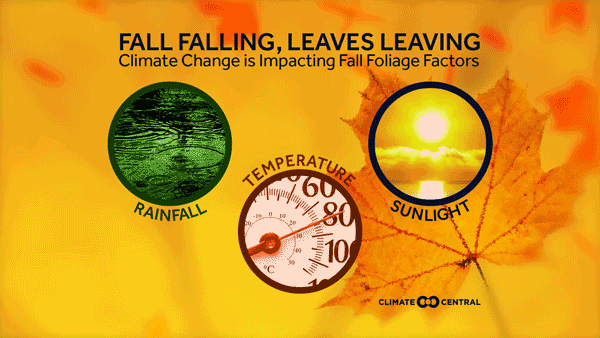With the end of September fast approaching, many people across the U.S. are eagerly watching the trees for their annual display of brilliantly colored fall foliage. A drop in temperatures and a change in the amount of daily sunlight are the standard cues for trees to begin shutting down for winter — changing the colors of their leaves in the process. Just how stunning the display is and when it starts vary from year-to-year, driven in large part by summer and autumn temperatures and precipitation.
In general, temperatures and precipitation in a particular year are useful predictors for when that burst of color will occur at a certain latitude. Moderate heat stress tends to delay leaf turn, while high heat stress or drought will cause colors to appear earlier and disappear faster. For example, this year’s drought in New England is expected to cause an earlier start to foliage season but with duller colors, particularly where the drought is severe or extreme. An increase in precipitation will usually delay the appearance of color, but too much rain could be a stressor for the trees, and, just like a drought, cause leaves to change early.
With climate change expected to alter both temperatures and precipitation, fall foliage will also be affected. Projections for the end of the century suggest the warmer temperatures would delay the onset of peak colors, but also make them disappear sooner, leading to a shorter season. Nationwide precipitation projections are a bit less certain, but signs point to an increase in the Northeast, further delaying fall colors there. The effects of this are both ecologically and economically important. Leaf-peeping is a multi-billion dollar a year ecotourism industry for many states.
Tree species are expected to migrate poleward as the climate changes, creating ecological mismatches, particularly with regard to how much sunlight they get. Because there is less daylight in the fall in higher latitudes, it could leave trees with a sunlight deficit. Some trees are also expected to migrate up in elevation, and while this won’t have an effect on exposure to sunlight, it could lead to other issues as they come in competition with other forests and the plants and animals they support.
Year-to-year variability of the colors and their peak is also expected to increase. This will make predicting the timing of peak colors more difficult, for two reasons. The first is that different species, which already have different reactions to weather, will respond differently to the effects of climate change. The second is that climate change itself is increasing the probability of certain types of extreme weather events, such as heavy precipitation, which can destroy the foliage season in a single day.
Yingying Xie at SUNY Buffalo was interviewed for this Climate Matters. You can read her dissertation here.
